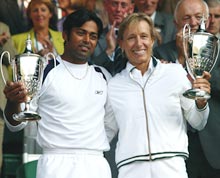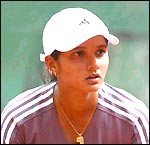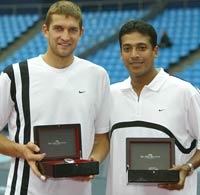Home > Sports > News > PTI > Report
Youth offer hope for Indian tennis
K Kumaraswamy |
December 24, 2003 18:51 IST
There was more than a ray of hope on the horizon but Indian tennis in 2003 continued to look up to the old messiah for deliverance.
Rohan Bopanna announced his arrival on the big stage with a courageous performance in the Davis Cup play-off; Prakash Amritraj, the son of the legendary Vijay Amritraj, left a blazing trail on his way to the top of the Indian rankings, and Sania Mirza, with her historic Wimbledon crown, marked the changing face of the women's game in the country.
Yet, the entire nation looked up the 'Miracle Man' of Indian tennis for salvation.
 Leander Paes, at 30, rejuvenated his own sagging career, winning two Grand Slam titles in partnership with Martina Navratilova. But without his magical inspiration India stumbled for the fourth consecutive time at the play-off stage of the Davis Cup.
Leander Paes, at 30, rejuvenated his own sagging career, winning two Grand Slam titles in partnership with Martina Navratilova. But without his magical inspiration India stumbled for the fourth consecutive time at the play-off stage of the Davis Cup.
The brain cyst that laid him low in the middle of the season brought out those fighting qualities in the man who time and again pulled off miraculous victories for the country, overcoming a series of adversities in his colourful career. And the mass outpouring of love for Paes one saw when a billion voices prayed for his recovery was something unheard of.
Paes did eventually come out of hospital but his absence from the World Group qualifying tie proved to be a major handicap for India, who lost 5-0 to the Netherlands.
Nevertheless, India did unearth a hero in defeat at Zwolle. In one of the longest matches in Cup history since the tie-break was introduced, Rohan Bopanna almost pulled the rug from under the feet of Martin Verkerk. Stretching a top-20 player to five sets was in itself an achievement. And, ranked in the 400s, had Bopanna pulled it off -- he lost the decider 12/10 -- it would have been a truly 'Leanderian' achievement.
 In a country that can boast of few sporting achievements, what Bopanna did that September evening was akin to a 15-year old Sachin Tendulkar taking Abdul Qadir to the cleaners. To be sure, the wiry 23-year old lad from Coorg, Karnataka, was not exactly playing in his maiden Davis Cup tie. When he entered the cauldron that was Eisselhallen, Bopanna had two wins under his belt, but those had come in a more friendly environment of grass surface at home. More importantly, he looked a slaughtered lamb in his defeat against Australia when he made his debut in a similar play-off last season.
In a country that can boast of few sporting achievements, what Bopanna did that September evening was akin to a 15-year old Sachin Tendulkar taking Abdul Qadir to the cleaners. To be sure, the wiry 23-year old lad from Coorg, Karnataka, was not exactly playing in his maiden Davis Cup tie. When he entered the cauldron that was Eisselhallen, Bopanna had two wins under his belt, but those had come in a more friendly environment of grass surface at home. More importantly, he looked a slaughtered lamb in his defeat against Australia when he made his debut in a similar play-off last season.
In Zwolle, the Dutch had assembled their best team, and it was on fast hard courts away from home. But in more than four hours he spent on court that Friday, Bopanna had won many a heart with his fighting performance.
In the end, it did not matter that he did not win – none expected him to -- but the bold manner in which he put his best foot forward and cut down the ego of the home team to size augured well for Indian tennis.
After Bopanna's marathon performance, Prakash Amritraj lost in straight sets to Sjeng Schalken and although Bhupathi and Bopanna started promisingly in the doubles rubber, the Indians were actually running for cover over the next two days. Amritraj did nothing earth-shattering that day but well before his first match in Indian colours, the 19-year old US-born lad had truly established himself as the number one Indian player on the circuit.
"Having a famous surname does not help you win matches, does it," Amritraj had said, smiling after losing in a Challenger event in India in April. Behind that smile were hidden attributes handed down to him by his famous father that helped him zoom from the 1000s to top-300 in ATP rankings.
He returned to the same dusty courts two months later for the Satellite circuit, where he truly 'came, saw and conquered' the competition and hearts.
For a player whose bread and butter was serve and volley, Amritraj's rapid rise was a fantastic achievement in every sense. If anything, it presented a pleasant contrast to the eyes weary of the baseline slugfests. And besides blowing away the myth that successful fathers don't foster successful sons, it also assured Indian fans that the sport has other talents to look up to besides the ageing Paes and Bhupathi.
 In the meanwhile, Sania confirmed her transition from promising talent to champion material by winning the Wimbledon girls' doubles title. It was the first by an Indian girl and the first junior Grand Slam title in any discipline since Paes won the Wimbledon boys' singles title in 1991.
In the meanwhile, Sania confirmed her transition from promising talent to champion material by winning the Wimbledon girls' doubles title. It was the first by an Indian girl and the first junior Grand Slam title in any discipline since Paes won the Wimbledon boys' singles title in 1991.
It took Sania to the No. 3 position in the junior doubles rankings. Besides, the six ITF singles titles to her name proved that she was no flash in the pan. With wise parents and sound sponsors backing her, the 17-year-old could set new standards for women's tennis in India in the coming years.
But just when it seemed Sania would leave the rest of the competition in her wake, Isha Lakhani stormed her way to become the highest ranked Indian woman for the year. In one of those sporting ironies, Isha, who was left out of the Indian team for the Afro-Asian Games squad, stunned Sania in the first round of a Challenger event that followed suit and moved ahead of her more famous compatriot into the top-400s of the WTA Tour rankings.
In 2004, the country will expect tennis to snatch a gold at the Olympics. But for that to happen, Paes and Bhupathi will have to team up again. And there is every reason to believe that the former world number one and Slam-winning pair will indeed come together.
The second parting seemed to have done more good than bad to both the players. For although he had a miserable year in 2002 and his career seemed to run into a desert sand, Paes regained his familiar vigour after pairing with the legendary Navratilova and went on to win the Australian Open and Wimbledon mixed doubles titles. He also won two ATP doubles title with David Rikl of the Czech Republic and more was in the offing -- including a brief reunion with Bhupathi – when the bacterial infection of the brain struck him down.
 Bhupathi too had a successful year after an indifferent start to the season, although he finished without a Grand Slam title. After the discordant note he struck with Joshua Eagle in the beginning, the seven-time Grand Slam champion went back to his last year partner Max Mirnyi of Belarus and the results began to flow immediately.
Bhupathi too had a successful year after an indifferent start to the season, although he finished without a Grand Slam title. After the discordant note he struck with Joshua Eagle in the beginning, the seven-time Grand Slam champion went back to his last year partner Max Mirnyi of Belarus and the results began to flow immediately.
It was absorbing stuff as the two estranged partners went neck and neck in the race for highest number of career titles.
Bhupathi and Mirnyi were definitely the better pair, with the latter in the course of the season becoming the number one in the Doubles Entry Ranking. The duo won five ATP titles, including three Masters crowns.
Bhupathi eventually finished with 31 career titles, as against Paes's 27, but the Indo-Belarussian pair had to contend end the annual team rankings behind the Bryan brothers, Bob and Mike, of the US.
Such a productive year for Indian tennis last came in 2001 when the Indian Express reunited after the first separation. Will they be able to rework their magic at Athens in 2004 is the question uppermost in the minds of Indian sports fraternity.